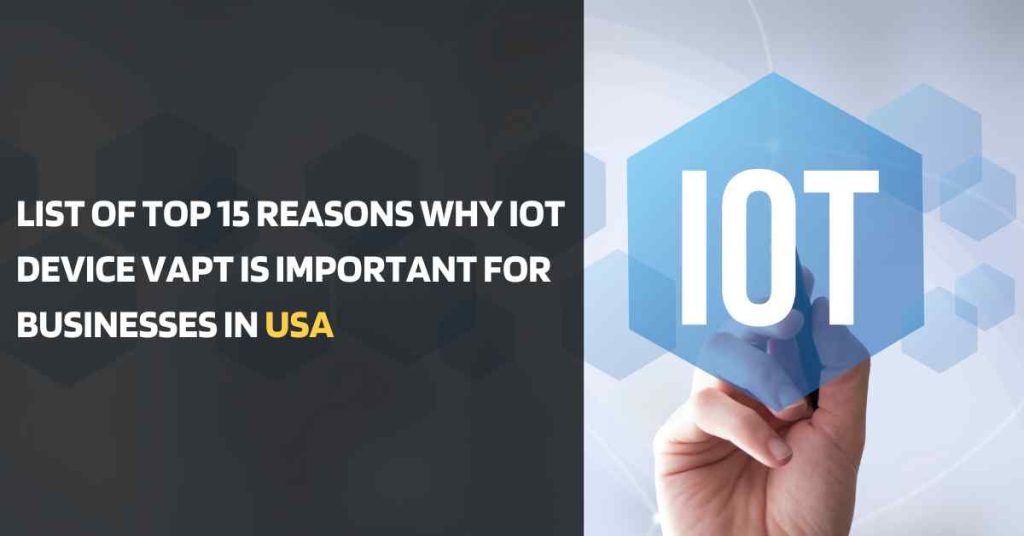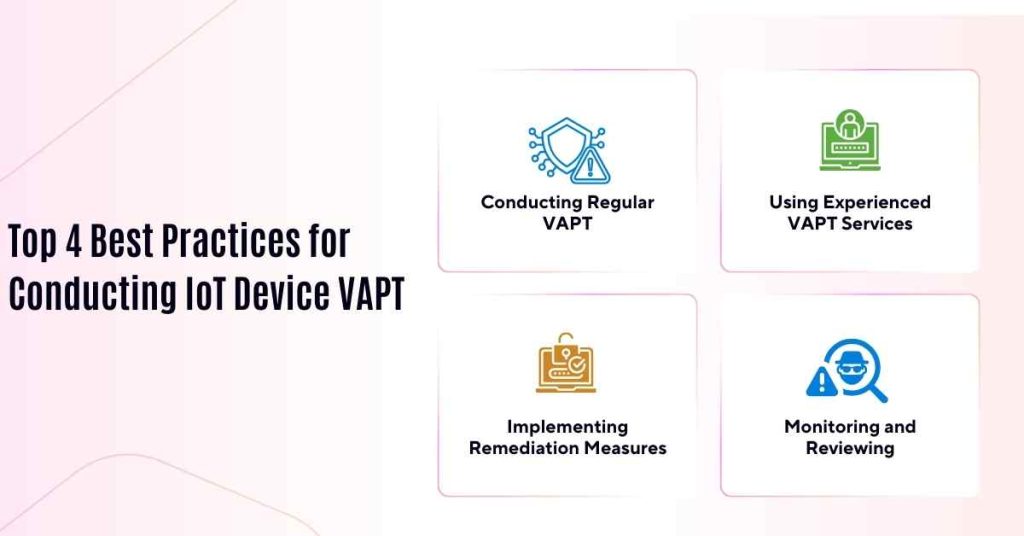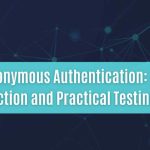The IoT has revolutionized the way businesses operate in the United States. With the increasing number of connected devices, businesses can now collect and analyze vast amounts of data, making informed decisions, and improving their operations. However, with this increased connectivity comes the risk of cyber threats.
IoT devices are often vulnerable to attacks, which can compromise the security of the entire network. Therefore, businesses need to conduct regular Vulnerability Assessment and Penetration Testing (VAPT) on their IoT devices.
In this article, we will discuss the top 15 reasons why IoT device VAPT is crucial for businesses in the United States.
List of Top 15 Reasons Why IoT Device VAPT is Important for Businesses in the United States

Here is the list of the Top 15 Reasons Why IoT Device VAPT is Important for Businesses in the United States:
1. Protection against Data Breaches
IoT devices feature data gathering and transmission capabilities and this is why they may become the target for cyber criminals.
Some of the consequences of a data breach include; leakage of important information, compromise of reputation and financial loss.
A VAPT of the IoT devices should be conducted at regular intervals to avoid such breaches with the following benefits;
2. Compliance with Regulations
The USA has some regulations and policies concerning the use of IoT devices such as the CCPA and the NYDFS Cybersecurity Regulation.
The analysis of vulnerabilities with VAPT on IoT devices can assist organizations in proving compliance with these critical regulations and staying out of fines and penalties.

3. Prevention of Financial Losses
An invasion of an IoT device can lead to a drainage of large sums of money for any firm. The same study from IBM revealed that the average expense of a data breach is $3.92 million in the United States.
It will be beneficial to perform VAPT on IoT devices to detect vulnerabilities and prevent further losses.
4. Protection of Intellectual Property
IoT devices hold the question of many software codes and algorithms, all of which are major components of intellectual property.
Performing testing known as VAPT on IoT devices is one way of tracing loopholes that could lead to theft of intellectual property.
5. Minimization of Downtime
A cyber attack on an IoT device will lead to time loss for a business which is not good for productivity and sales.
Implementation of VAPT on IoT devices can assist in the discovery of weaknesses and reduce the time spent on the devices.
6. Identification of Zero-Day Vulnerabilities
The zero-day vulnerability is the unaddressed opening that assailants can use and exploit in the software or hardware.
On the same note, we can conduct VAPT on the IoT devices so that we can prevent such attacks and also highlight attacks that have not been registered such as the zero-day vulnerabilities.
7. Evaluation of IoT Device Security
VAPT can help to evaluate the security of IOT devices and risks that the hacker may be able to harness.
This can assist the corporate world in solving the problems that relate to IoT deployment and management.
8. Discovery of Hidden Backdoors
These are clandestine entrances into the IoT devices which are vulnerable to attackers.
During the VAPT of the IoT devices, one can identify the currently existing backdoors, which the attackers use to gain access to the system.
9. Protection of User Information
IoT devices receive and may even store data inputs from different users, which include geographical location and identity details.
Carrying out VAPT on IoT devices can assist in discovering risks and thus stopping users’ data theft.
10. Minimization of Reputation Risk
A breach in IoT devices can also lead to reputational loss to firms, which costs time and other resources to regain people’s faith in the respective organizations.
It is also true that performing VAPT on IoT devices can go a long way in decreasing the reputation risk.
11. Prevention of Physical Harm
Some of the IoT devices that are incorporated in the SCADA systems used in industrial processes have real-world effects.
Conducting the VAPT on such devices helps in preventing actual endangerment and ensures the safety of the people.
12. Evaluation of Supply Chain Risks
The IoT devices are dependent on third parties for supplies and vendors, so that is a risk to the supply chain. VAPT on IoT devices can help assess these threats and attacks to eradicate them.
13. Protection of Network Security
Thus, IoT devices continue still to be potential threats to the existing networks, if the security of these gadgets is not heightened enough.
By performing the VAPT on IoT devices, one can be able to discover the existing gaps and prevent intrusions on the network.
14. Identification of Misconfigured Devices
IoT devices if configured incorrectly pose a security threat to an organization. VAPT for IoT devices can prevent attacks and also identify misconfigured IoT devices.
15. Evaluation of Emerging Threats
The threat landscape for IoT devices is constantly evolving, with new threats emerging every day. Conducting VAPT on IoT devices can help evaluate emerging threats and prevent attacks.
Top 4 Best Practices for Conducting IoT Device VAPT

To get the most out of IoT device VAPT, businesses should follow best practices, including:
1. Conducting Regular VAPT
Such VAPT can aid in the detection of exploitable weaknesses and the possibility of an attack.
2. Using Experienced VAPT Services
It is recommended to engage skilled VAPT services for the IoT devices to get the devices tested and evaluated adequately.
3. Implementing Remediation Measures
Implementing measures for reconstruction could eliminate risks and oppression that may be put into use by the attackers.
4. Monitoring and Reviewing
The results of VAPT must be properly monitored and reviewed to verify the security and conformity of IoT gadgets.
Summary
Here is the summary of blog title ” Top 15 Reasons Why IoT Device VAPT is Important for Businesses in the United States ” :
- Protection against Data Breaches
- Compliance with Regulations
- Prevention of Financial Losses
- Protection of Intellectual Property
- Minimization of Downtime
- Identification of Zero-Day Vulnerabilities
- Evaluation of IoT Device Security
- Discovery of Hidden Backdoors
- Protection of User Information
- Minimization of Reputation Risk
- Prevention of Physical Harm
- Evaluation of Supply Chain Risks
- Protection of Network Security
- Identification of Misconfigured Devices
- Evaluation of Emerging Threats
Conclusion
IoT device VAPT is a critical process that can help businesses ensure the security and integrity of their IoT devices. By conducting regular VAPT, businesses can identify vulnerabilities, prevent attacks, and minimize the risk of data breaches and reputational damage.
With the increasing number of connected devices, businesses need to prioritize IoT device security and make informed decisions about the deployment and management of IoT devices.
FAQs: Top 15 Reasons Why IoT Device VAPT is Important for Businesses in the United States
1. What is IoT Device VAPT and why is it important?
Ans: IoT Device VAPT stands for Vulnerability Assessment and Penetration Testing. It is a process of evaluating the security of IoT devices to identify vulnerabilities and weaknesses that can be exploited by hackers. IoT Device VAPT is important because it helps businesses ensure the security and integrity of their IoT devices, prevent data breaches, and minimize the risk of reputational damage.
2. What is the difference between Vulnerability Assessment and Penetration Testing?
Ans: Vulnerability Assessment is a process of identifying vulnerabilities and weaknesses in IoT devices, while Penetration Testing is a simulation of an attack on the IoT device to evaluate its defences. Both Vulnerability Assessment and Penetration Testing are essential components of IoT Device VAPT.
3. What types of vulnerabilities can be detected through IoT Device VAPT?
Ans: IoT Device VAPT can detect a wide range of vulnerabilities, including software vulnerabilities, hardware vulnerabilities, configuration vulnerabilities, and authentication vulnerabilities. Hackers can exploit these vulnerabilities to gain unauthorized access to IoT devices, steal sensitive data, or disrupt business operations.
4. How often should I conduct IoT Device VAPT?
Ans: IoT Device VAPT should be conducted regularly, ideally every 6-12 months, or whenever there are changes to the IoT device or its network. This ensures that any new vulnerabilities or weaknesses are identified and addressed promptly, reducing the risk of a security breach.
5. What are the benefits of conducting IoT Device VAPT?
Ans: The benefits of conducting IoT Device VAPT include improved security, compliance with regulations, reduced financial losses, protection of intellectual property, and minimization of downtime. Regular VAPT can also help businesses demonstrate due care and diligence in maintaining the security of their IoT devices.
6. Can I conduct IoT Device VAPT in-house or should I hire a third-party service provider?
Ans: While it is possible to conduct IoT Device VAPT in-house, it is recommended to hire a third-party service provider with expertise in VAPT and IoT device security. Third-party service providers can provide an independent and objective assessment of the IoT device’s security, identifying vulnerabilities and weaknesses that may not be apparent to in-house teams.
7. What should I look for when hiring a third-party service provider for IoT Device VAPT?
Ans: When hiring a third-party service provider for IoT Device VAPT, look for a provider with expertise in VAPT, IoT device security, and relevant industry certifications such as CISSP or CEH. The provider should also have a proven track record of conducting VAPT on IoT devices similar to yours and should be able to provide clear and actionable recommendations for remediation.
8. How long does IoT Device VAPT typically take to complete?
Ans: The duration of IoT Device VAPT can vary depending on the complexity of the IoT device, the size of the network, and the scope of the testing. Typically, IoT Device VAPT can take anywhere from a few days to several weeks to complete, depending on the extent of the testing and the level of detail required.
9. What are the most common vulnerabilities found in IoT devices?
Ans: The most common vulnerabilities found in IoT devices include weak passwords, outdated software, insecure communication protocols, and inadequate encryption. These vulnerabilities can be exploited by hackers to gain unauthorized access to IoT devices, steal sensitive data, or disrupt business operations.
10. What should I do with the results of an IoT Device VAPT?
Ans: The results of an IoT Device VAPT should be reviewed and prioritized based on the severity of the vulnerabilities identified. The vulnerabilities should then be remediated in a timely and effective manner, using the recommendations provided by the VAPT report. Additionally, the results of the VAPT should be used to inform future security testing and to improve the overall security posture of the IoT device.












